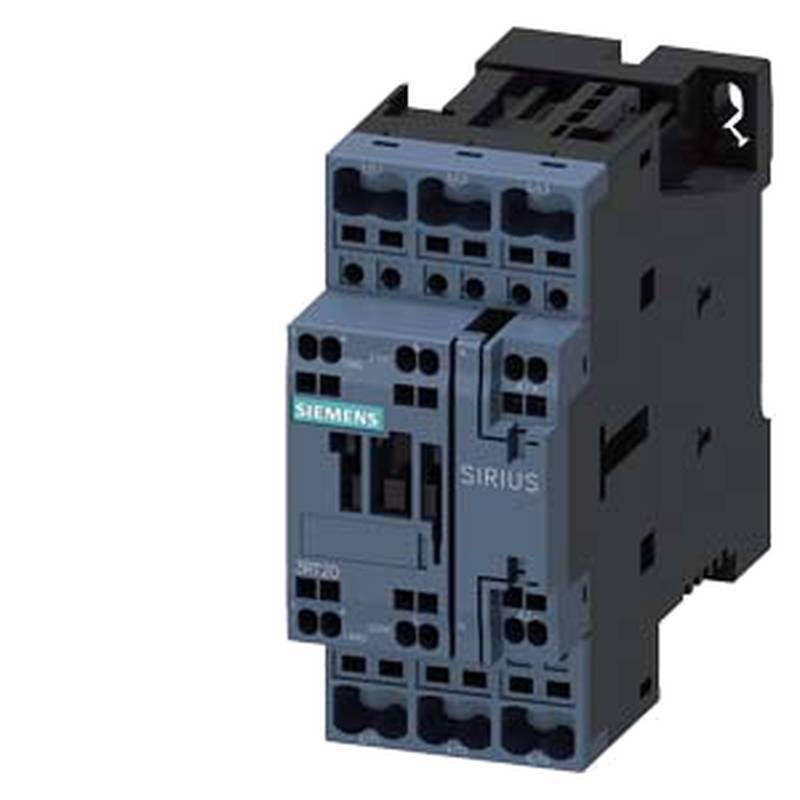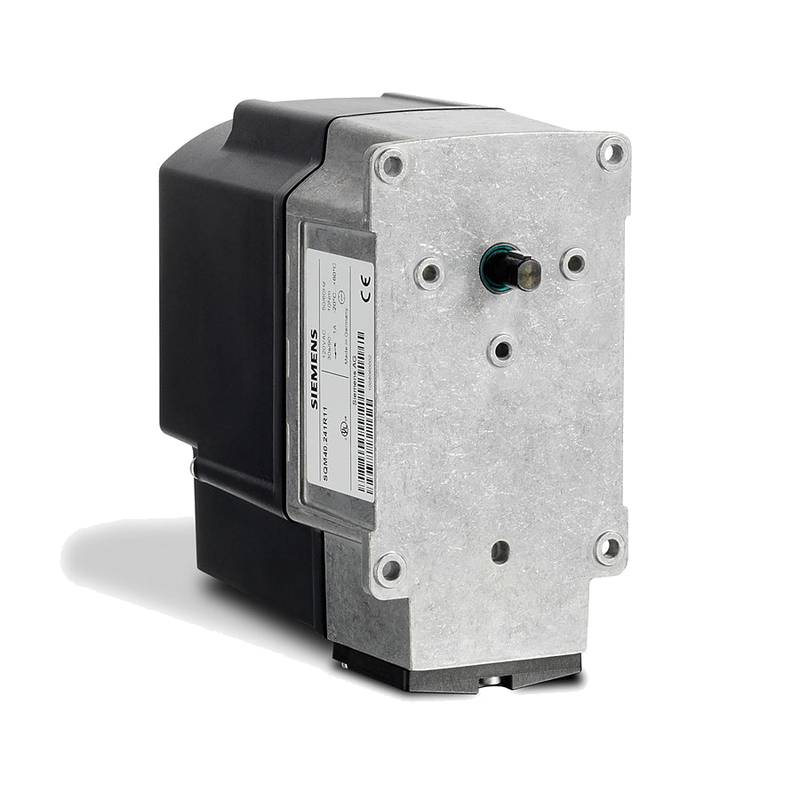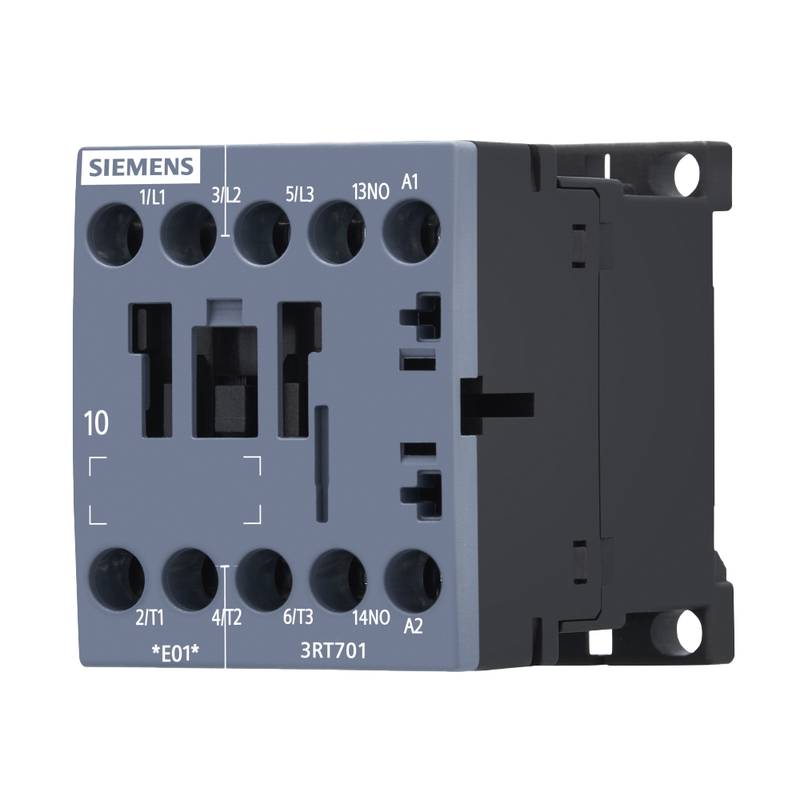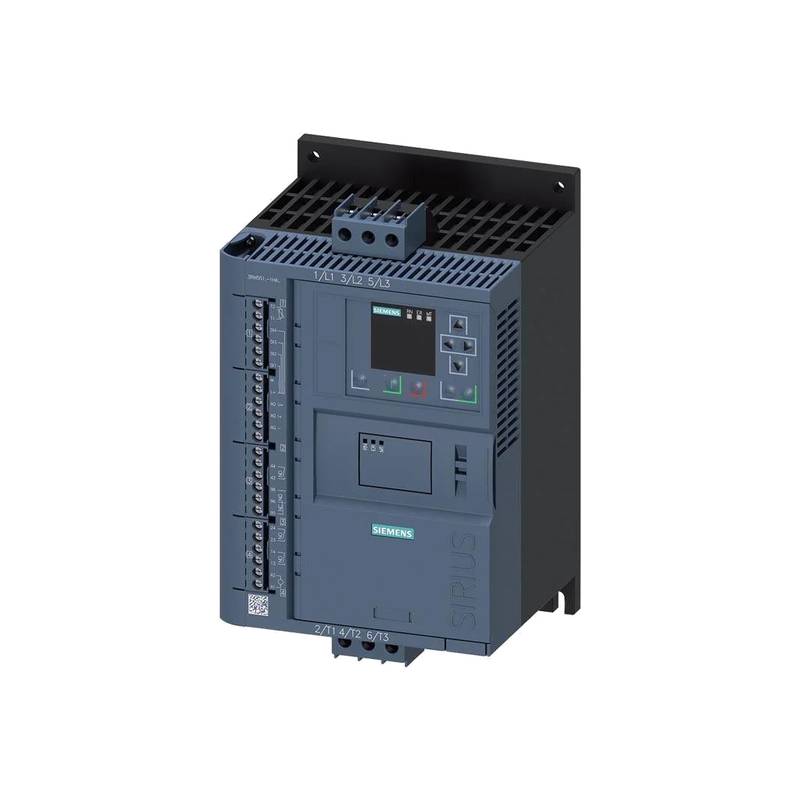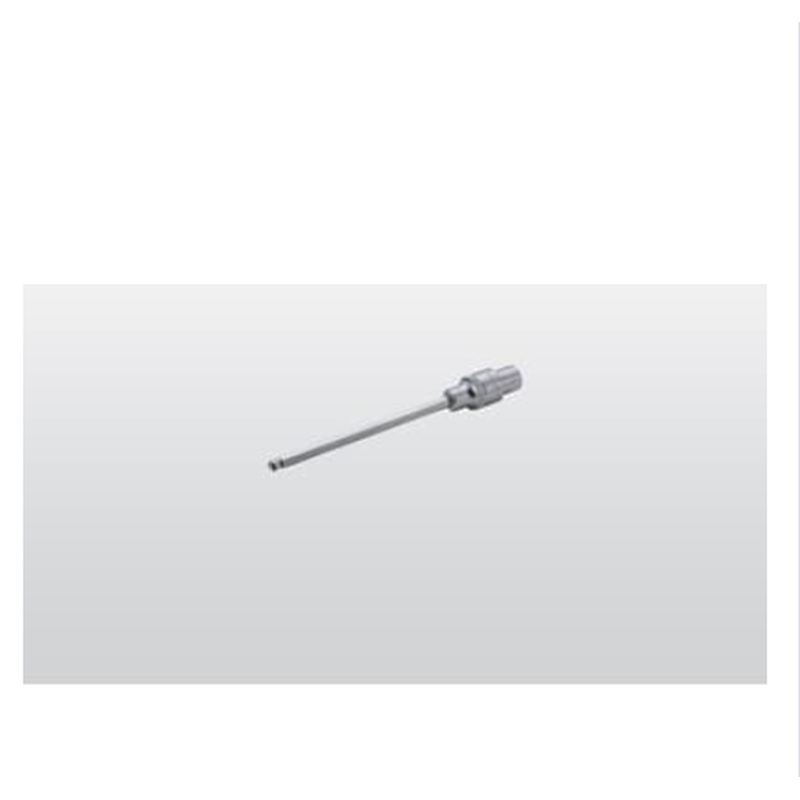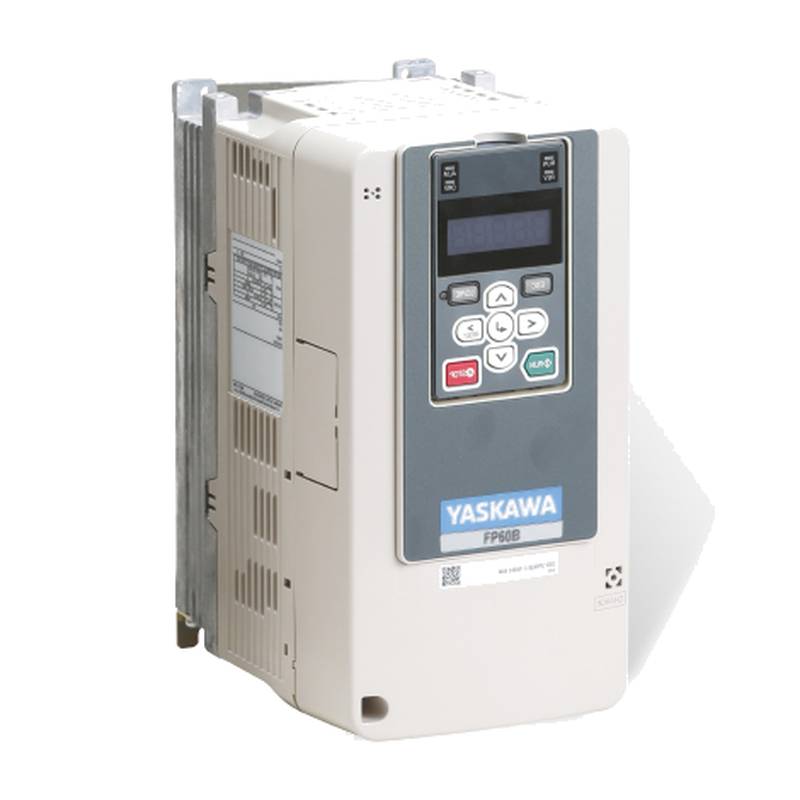
The Siemens 3RT2026-2NB30 is a robust and reliable motor reversing contactor designed for efficient control of three-phase motors in demanding industrial environments. This unit boasts a compact size, high switching capacity of 25A, and a versatile control voltage range of 21-28VAC/DC, making it a prime choice for forward and reverse motor operation. Its key advantages lie in its Siemens quality, ensuring long operational life, and its straightforward integration into existing control systems. Core features include three normally open (NO) auxiliary contacts, a robust construction for frequent switching, and inherent safety mechanisms conforming to international standards. Technically, it operates within a nominal voltage of up to 690V and offers excellent thermal current ratings.
Product Specifications
| Feature | Specification |
| :---------------------- | :------------------------------------------ |
| Product Type | Motor Reversing Contactor |
| Siemens Model Number | 3RT2026-2NB30 |
| Rated Operational Current | 25 A |
| Control Voltage | 21-28 VAC/DC |
| Number of NO Contacts | 3 |
| Number of NC Contacts | 0 |
| Auxiliary Contacts | 3 NO |
| Rated Insulation Voltage | 690 V |
| Conventional Thermal Current | 25 A |
| AC-3 Utilization Category | 12 A at 400 V |
| Mounting Type | Rail-Mountable (35mm DIN rail) |
| Protection Class | IP20 |
| Operating Temperature | -25 to +60 °C |
Core Features & Market Positioning
The Siemens 3RT2026-2NB30 distinguishes itself through its adherence to Siemens' stringent quality and reliability standards, a critical factor in industrial automation where downtime is costly. Its market positioning is as a dependable, mid-range solution for basic motor reversing applications, offering a balance of performance and cost-effectiveness. Unlike some higher-end controllers, its straightforward design simplifies installation and maintenance, appealing to facilities prioritizing ease of use and robust functionality over advanced digital integration. The inclusion of three NO auxiliary contacts offers immediate flexibility for interlocking or signaling circuits, a significant advantage over contactors with fewer auxiliary options. This focus on core performance and dependable operation makes it a preferred choice for established machinery and standard control panels.
Key Application Scenarios
This Siemens reversing contactor is ideally suited for applications requiring frequent motor direction changes. Common scenarios include material handling systems, such as conveyors and elevators, where loads need to be moved in both directions. It is also widely deployed in pump applications, allowing for efficient draining or filling operations, and in fan systems for ventilation control. Machine tool applications, like drilling or milling machines, benefit from the precise control offered by the 3RT2026-2NB30 for tool positioning and operation. Its 25A rating makes it suitable for a range of medium-duty industrial motors.
Practical System Integration Guidance
Integrating the Siemens 3RT2026-2NB30 into a control panel is facilitated by its standard 35mm DIN rail mounting. Wiring involves connecting the main power lines to the terminals for forward and reverse operation, ensuring proper phase rotation. The control circuit connects to the coil terminals (A1 and A2), respecting the AC/DC voltage of 21-28V. For reversing logic, two such contactors are typically used in conjunction with mechanical or electrical interlocks to prevent simultaneous engagement, which could lead to short circuits. The three NO auxiliary contacts can be wired into the control logic for status feedback or to implement safety interlocks. For example, an auxiliary contact from one contactor can be wired in series with the coil of the other to provide electrical interlocking.
Operation and Risk Mitigation
Operating the Siemens 3RT2026-2NB30 involves applying the correct voltage to its coil to energize and de-energize the contactor, thereby switching the motor's power circuit. Proper risk mitigation involves ensuring the control voltage is within the specified 21-28VAC/DC range to prevent coil damage. Electrical interlocking is paramount when using two units for reversing applications to prevent phase-to-phase short circuits. Always adhere to local electrical codes and standards during installation and operation. While the contactor itself offers a degree of protection, it's essential that the overall system includes appropriate overcurrent protection and emergency stop mechanisms to ensure personnel safety.
Scalability & Long-Term Value
The Siemens 3RT2026-2NB30 provides solid long-term value through its durability and compatibility with Siemens' broader SIRIUS modular system. While this specific model is not inherently "smart" in the IIoT sense, it can be integrated into digitally connected systems. This integration typically involves using auxiliary contacts or other discrete signals from the contactor to feed data into a PLC or SCADA system for monitoring and control. For applications requiring advanced diagnostics or remote control, one would interface this contactor with compatible controllers. The availability of spare parts and the established reputation of Siemens ensure continued support and ease of maintenance over the product's lifecycle, contributing to its overall scalability within evolving industrial automation architectures.
FAQs
What is the primary function of the Siemens 3RT2026-2NB30?
This contactor's main role is to control the direction of three-phase motors. It allows for switching between forward and reverse operation.
It achieves this by reconfiguring the power connections to the motor's windings. This is essential for applications needing bidirectional movement.
The 3RT2026-2NB30 is designed for frequent switching cycles, ensuring reliability in dynamic industrial processes.
Can the Siemens 3RT2026-2NB30 be used with AC and DC power?
Yes, the control coil of this contactor is designed for a versatile voltage range of 21-28VAC/DC. This dual capability simplifies system design.
This flexibility allows it to be integrated into control systems powered by either AC or DC auxiliary power supplies. It's crucial to verify the supply matches the specified range.
Always ensure the correct polarity is observed if using a DC supply to prevent potential damage to the coil. The N prefix in the model number often indicates this AC/DC capability.
What are the advantages of using Siemens contactors like the 3RT2026-2NB30?
Siemens contactors are renowned for their high reliability and long operational lifespan. This reduces maintenance and replacement costs.
They offer a compact design, facilitating space-saving installations in control panels. Their robust construction withstands harsh industrial environments.
The 3RT2026-2NB30 provides three normally open auxiliary contacts, offering immediate flexibility for interlocking and signaling circuits. This enhances system functionality and safety.
How is the Siemens 3RT2026-2NB30 installed in a control panel?
Installation is typically done by mounting the contactor onto a standard 35mm DIN rail. This ensures secure and quick mounting.
The main power terminals are connected to the motor's power supply, and the control coil is connected to the control voltage source. Proper wiring is essential for correct operation.
It is critical to use electrical or mechanical interlocking when pairing two of these contactors for reversing applications to prevent short circuits. Always follow wiring diagrams.
What is the maximum current rating for the Siemens 3RT2026-2NB30?
The rated operational current for this contactor is 25 Amperes. This indicates the continuous current it can handle.
The AC-3 utilization category specifies its performance for motor control, rated at 12A at 400V. This is crucial for selecting the correct contactor for specific motor loads.
Ensure the motor's full load current does not exceed the contactor's rating, considering the application's duty cycle and starting conditions.
What is the purpose of the auxiliary contacts on the 3RT2026-2NB30?
The three normally open (NO) auxiliary contacts provide additional switching capabilities. They are electrically separate from the main power contacts.
These contacts are commonly used for signaling purposes, such as indicating the contactor's state (energized or de-energized) to a PLC or control system. They also enable interlocking functions.
They can be wired to create safety interlocks, such as preventing a second contactor from energizing if the first is already active, thereby preventing dangerous states.
Can this contactor be used for frequent starting and stopping of a motor?
Yes, the Siemens 3RT2026-2NB30 is designed for frequent switching operations. Its construction ensures durability for such applications.
The AC-3 rating is specifically for direct-on-line starting of squirrel-cage motors, indicating its suitability for typical motor start/stop cycles.
However, extreme switching frequencies or severe starting conditions may require consulting Siemens application guidelines or selecting a heavier-duty contactor to ensure maximum longevity.
What type of motor applications is the 3RT2026-2NB30 best suited for?
It is ideal for applications requiring bidirectional motor control, such as conveyors, pumps, and fans. These often involve reversing direction.
Machine tools, where precise directional control of spindles or axes is needed, also benefit from this reversing contactor.
Its 25A rating makes it suitable for medium-sized three-phase motors commonly found in general industrial automation tasks.
How does electrical interlocking prevent short circuits when reversing a motor?
Electrical interlocking uses the auxiliary contacts of one contactor to prevent the coil of the other contactor from being energized. This ensures only one contactor is active at a time.
When the forward contactor is energized, its auxiliary contacts are wired to break the circuit to the coil of the reverse contactor. This is a critical safety feature.
This prevents the scenario where both forward and reverse contactors are simultaneously energized, which would create a direct short circuit across the power supply.
What is the operating temperature range for the Siemens 3RT2026-2NB30?
This contactor can operate reliably within a temperature range of -25°C to +60°C. This covers a broad spectrum of industrial environments.
Ensure that the ambient temperature around the contactor stays within this specified range for optimal performance and longevity. Excessive heat can lead to premature failure.
Proper ventilation within the control panel is crucial, especially when multiple contactors or other heat-generating components are installed, to maintain temperatures within acceptable limits.














